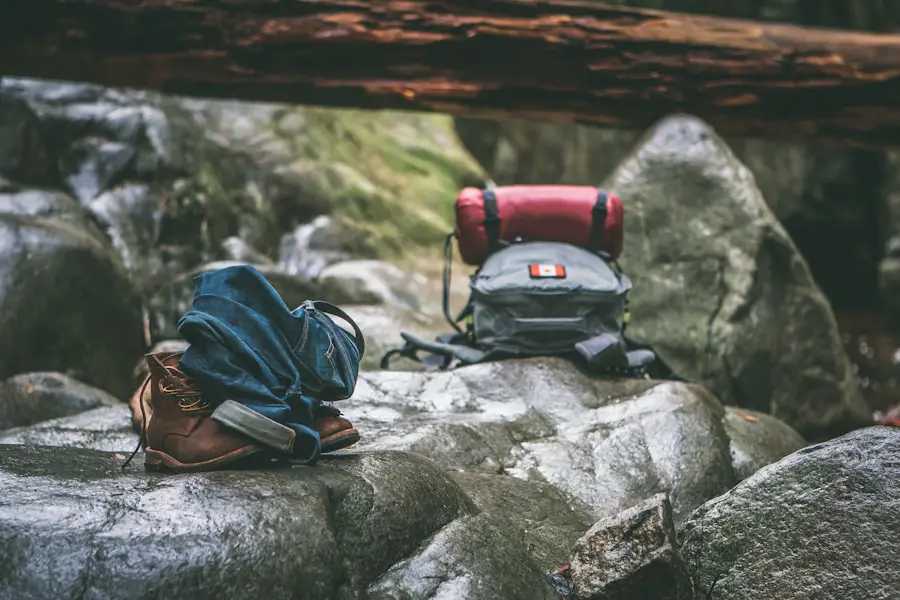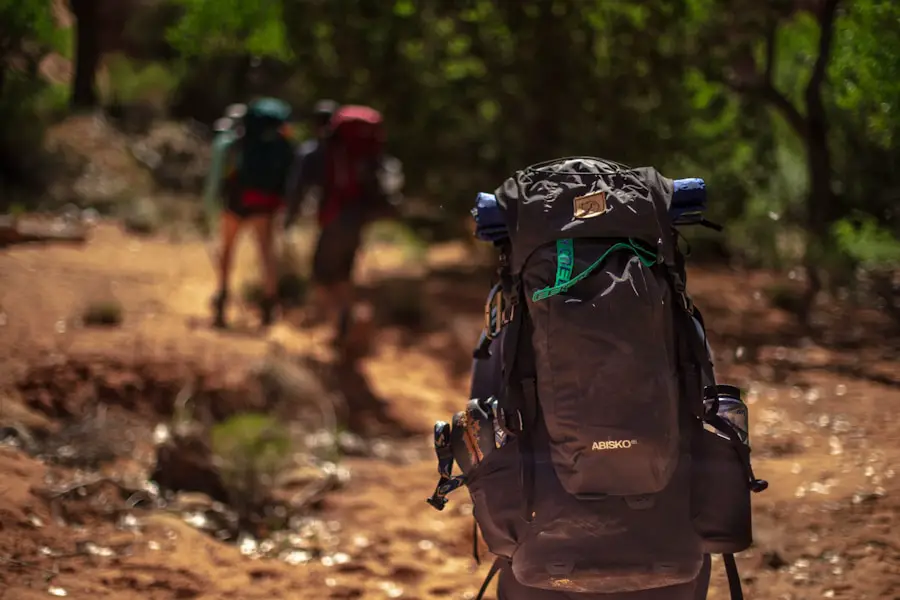Selecting the appropriate hiking boots is one of the most critical decisions a hiker can make. The right footwear not only enhances comfort but also significantly impacts performance and safety on the trail. When choosing hiking boots, it is essential to consider the terrain you will be traversing.
For instance, if your adventure involves rocky paths or steep inclines, a boot with a stiffer sole and robust ankle support is advisable. This type of boot provides the necessary stability and protection against potential injuries, such as sprained ankles. Conversely, if you plan to hike on well-maintained trails, a lighter boot or even a trail runner may suffice, offering breathability and agility.
Fit is another paramount factor in selecting hiking boots. A proper fit ensures that your feet remain comfortable over long distances, reducing the risk of blisters and other foot ailments. When trying on boots, it is recommended to wear the same type of socks you plan to use on your hike.
Pay attention to the toe box; your toes should have enough room to wiggle without feeling cramped. Additionally, consider the width of the boot; some brands offer various widths to accommodate different foot shapes. It’s also wise to walk around in the boots for a while in the store to assess comfort and support before making a purchase.
Key Takeaways
- Choose hiking boots that provide ankle support and have a good tread for traction on various terrains.
- Layer clothing for comfort and protection, including moisture-wicking base layers and waterproof outer layers.
- Find a backpack that fits your torso length and has adjustable straps for a comfortable fit.
- Carry maps, a compass, and a GPS device for navigation and always know how to use them.
- Pack a first aid kit with essential supplies such as bandages, antiseptic wipes, and pain relievers for safety on the trail.
Clothing: Layering for Comfort and Protection
When it comes to hiking attire, layering is the key to maintaining comfort and protection against the elements. The layering system typically consists of three main layers: a base layer, an insulating layer, and an outer shell. The base layer, which is worn closest to the skin, should be made of moisture-wicking materials such as merino wool or synthetic fabrics.
This layer helps to keep sweat away from the body, which is crucial for regulating body temperature during physical exertion. For example, a lightweight merino wool shirt can provide warmth while also managing moisture effectively. The insulating layer serves to retain body heat and can be made from materials like fleece or down.
This layer is particularly important in cooler conditions, as it traps warmth generated by your body. A fleece jacket is an excellent choice for this layer due to its lightweight nature and breathability. Finally, the outer shell protects against wind, rain, and snow.
Look for jackets made from waterproof and breathable materials such as Gore-Tex or similar technologies. These jackets not only shield you from the elements but also allow moisture from sweat to escape, preventing overheating.
Backpack: Finding the Right Size and Fit

Choosing the right backpack is essential for any hiking trip, as it directly affects your comfort and ability to carry necessary gear. The first step in selecting a backpack is determining its size based on the duration of your hike. Day hikes typically require a smaller pack ranging from 15 to 30 liters, while multi-day excursions may necessitate larger packs of 50 liters or more.
It’s crucial to consider not just the volume but also how the pack distributes weight across your body. A well-fitted backpack should sit comfortably on your hips with adjustable straps that allow for a customized fit. When trying on backpacks, pay attention to features such as hip belts and shoulder straps.
A padded hip belt can help transfer weight from your shoulders to your hips, reducing fatigue during long hikes. Additionally, look for adjustable sternum straps that can help stabilize the load and prevent shifting while you move. Many modern backpacks also come equipped with ventilation systems that promote airflow between your back and the pack, which can be particularly beneficial during strenuous hikes in warm weather.
Navigation: Maps, Compass, and GPS
| Navigation Tool | Usage | Accuracy |
|---|---|---|
| Maps | Used for visual representation of geographical areas | Depends on the source and scale |
| Compass | Used for determining direction | Highly accurate when calibrated properly |
| GPS | Used for precise location tracking | Accurate within a few meters |
Navigating through unfamiliar terrain requires a solid understanding of various navigation tools, including maps, compasses, and GPS devices. Traditional topographic maps provide detailed information about elevation changes, trails, water sources, and other critical features of the landscape. Learning how to read these maps is an invaluable skill for any hiker; it allows you to understand your surroundings better and make informed decisions about your route.
For instance, recognizing contour lines can help you anticipate steep climbs or descents. While maps are essential, a compass serves as a reliable tool for orienting yourself in relation to your surroundings. Understanding how to use a compass in conjunction with a map can significantly enhance your navigation skills.
By identifying landmarks and using them as reference points, you can maintain your bearings even in challenging conditions. In recent years, GPS technology has become increasingly popular among hikers due to its convenience and accuracy. Handheld GPS devices or smartphone apps can provide real-time location tracking and route planning; however, it’s important not to rely solely on technology since batteries can die or devices can malfunction.
First Aid Kit: Essential Supplies for Safety
A well-stocked first aid kit is an indispensable part of any hiking adventure, as it prepares you for potential injuries or emergencies that may arise on the trail. When assembling your first aid kit, consider including items such as adhesive bandages in various sizes for minor cuts and scrapes, antiseptic wipes for cleaning wounds, and gauze pads for larger injuries. Additionally, incorporating pain relievers like ibuprofen or acetaminophen can help manage discomfort from strains or headaches.
Beyond basic supplies, it’s wise to include specialized items tailored to your specific needs or potential risks associated with your hiking environment. For example, if you’re hiking in areas where ticks are prevalent, adding tick removal tools can be crucial for preventing Lyme disease. Furthermore, including a small emergency blanket can provide warmth in case of sudden weather changes or injuries that require immobilization.
Regularly checking and replenishing your first aid kit ensures that you are always prepared for unforeseen circumstances.
Shelter: Tents, Sleeping Bags, and Tarps

When planning an overnight hiking trip or camping excursion, selecting appropriate shelter is vital for ensuring comfort and protection from the elements. Tents come in various styles and sizes; choosing one that suits your needs depends on factors such as the number of occupants and the expected weather conditions. For instance, a lightweight backpacking tent may be ideal for solo hikers looking to minimize weight while still providing adequate protection against rain and wind.
In addition to tents, sleeping bags play a crucial role in ensuring a good night’s sleep in the outdoors. When selecting a sleeping bag, consider its temperature rating; this rating indicates the lowest temperature at which the bag will keep you warm. Down sleeping bags are known for their excellent insulation-to-weight ratio but may not perform well when wet unless treated with water-resistant coatings.
Synthetic sleeping bags are bulkier but retain warmth even when damp. Tarps can also serve as versatile shelter options; they are lightweight and can be set up in various configurations depending on weather conditions.
Food and Water: Packing Nutritious Snacks and Hydration
Proper nutrition and hydration are essential components of any hiking trip; they directly influence energy levels and overall performance on the trail. When packing food for your hike, focus on nutrient-dense snacks that provide sustained energy without weighing you down. Trail mix is a popular choice due to its combination of nuts, seeds, dried fruits, and sometimes chocolate or granola; it offers a balance of carbohydrates, protein, and healthy fats.
Hydration is equally important; carrying enough water is crucial for preventing dehydration during physical exertion. A general guideline is to drink about half a liter of water per hour of moderate activity in moderate temperatures. Depending on the length of your hike and availability of water sources along the route, consider using hydration reservoirs or water bottles that are easy to access while on the move.
Additionally, if you plan to hike in remote areas where water sources may be scarce or contaminated, bringing along water purification tablets or filters can ensure safe drinking water.
Safety Essentials: Whistle, Fire Starter, and Emergency Blanket
In addition to basic gear and supplies, carrying safety essentials can make a significant difference in emergency situations while hiking. A whistle is an invaluable tool for signaling for help if you become lost or injured; its sound carries much farther than a human voice and requires less energy to use than shouting. Many outdoor enthusiasts recommend attaching a whistle to your backpack for easy access.
Fire starters are another critical safety item; they can help you create warmth or signal for assistance in emergencies. Options range from waterproof matches to magnesium fire starters that work even in wet conditions. Having multiple methods of starting a fire increases your chances of success when needed most.
Lastly, an emergency blanket—often made from reflective material—can provide warmth by trapping body heat in cold conditions or serve as a signaling device due to its bright color. Carrying these safety essentials ensures that you are better prepared for unexpected challenges during your outdoor adventures.
When preparing for a hiking trip, it’s important to consider all the essential gear you’ll need to bring along. One crucial item to pack is a high-quality sleeping bag, such as the ones recommended in this article. A good sleeping bag will keep you warm and comfortable during chilly nights in the great outdoors. Additionally, having a reliable power source is essential for charging your devices while on the trail, so investing in one of the best travel trailer batteries is a smart choice. And don’t forget to protect your camera gear with a durable and functional backpack, like the ones featured in this article. By being well-prepared with the right equipment, you can fully enjoy your hiking adventure without any worries.
Love travel? Join Our Facebook Community For More Tips.
FAQs
What should I bring on a hiking trip?
It is important to bring essential items such as water, food, navigation tools, first aid kit, appropriate clothing, and a backpack to carry everything.
How much water should I bring for a hiking trip?
It is recommended to bring at least 2 liters of water per person for a day hike. In hot or strenuous conditions, more water may be necessary.
What kind of food should I bring for a hiking trip?
Pack lightweight, high-energy snacks such as trail mix, energy bars, and dried fruits. For longer hikes, consider bringing sandwiches, wraps, or other portable meals.
What navigation tools should I bring for a hiking trip?
A map and compass are essential for navigation on a hiking trip. Consider also bringing a GPS device or a smartphone with a GPS app as a backup.
What should I include in a first aid kit for a hiking trip?
A hiking first aid kit should include items such as bandages, adhesive tape, antiseptic wipes, pain relievers, blister treatment, and any personal medications.
What clothing should I bring for a hiking trip?
Wear moisture-wicking and breathable clothing, and dress in layers to accommodate changing weather conditions. Don’t forget to bring a hat, sunglasses, and sunscreen for sun protection.
What kind of backpack should I bring for a hiking trip?
Choose a comfortable, properly fitting backpack with enough capacity to carry all your essentials. Look for features such as padded straps, a waist belt, and multiple compartments for organization.
